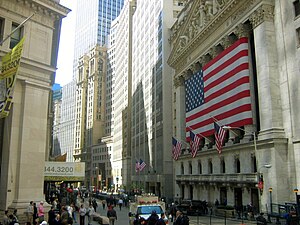| The New York Stock Exchange, the world's largest stock exchange by market capitalization (Photo credit: Wikipedia) |
New York, Jul.4, stock tips .- What should you do when your shorts fall down?
Celebrate! No, I'm not talking about an embarrassing situation that could land you on America's Funniest Home Videos. I'm referring to when you sell a stock short and the price drops.
Selling a stock short or "shorting" is when you sell a stock before you own it, hoping the price falls.
Huh? How can you sell a stock before you own it?
In order to short a stock, it has to be able to be borrowed. The investor actually borrows the stock from a broker, sells it and hopes to buy it back (and return it) at a lower price. It's the same as "buy low, sell high," but in reverse order.
Many, but not all, stocks are able to be borrowed. If the stock doesn't trade much volume, is extremely volatile or is already heavily shorted, it may not be borrowable.
Who Sells Short Shorts?
There are some money managers who are well-known for shorting. They typically have done a tremendous amount of research and see major flaws in conventional Wall Street thinking about a stock.
David Einhorn of Greenlight Capital will sometimes very publicly lay out his short case on a particular stock. Just the news that Einhorn is short can send a stock careening lower.
In the past, Einhorn publicly bashed Chipotle Mexican Grill (NYSE: CMG) and Green Mountain Coffee (Nasdaq: GMCR). He is perhaps most famous for his short of Lehman Brothers before it collapsed.
The average investor can sell short also. He just needs to be approved by his broker.
Why Sell Short?
An investor may short a stock for a variety of reasons. She could see a bearish chart pattern that leads her to believe a drop is imminent. She may determine that a stock is wildly overvalued, or perhaps know that the company's reported results may not reflect reality.
Several years ago, I wrote a column on St. Joe (NYSE: JOE), urging investors to short the stock. It was trading at $60 at the time, and I had information that led me to believe that sales had drastically slowed down and the company overvalued certain assets. Sure enough, the stock dropped to $30 as the market realized what I already knew.
The Short Squeeze
A short squeeze is like Christmas morning for a shareholder of the stock. When a stock that is heavily shorted starts to run up, many of those shorting it scramble to cover their position in order to avoid a heavy loss.
Since they sold the stock first, in order to exit the trade, they have to buy the stock back. That creates more demand for the stock, which pushes it higher, which forces more shorts to buy the shares and so on and so on.
Look at Ligand Pharmaceuticals (Nasdaq: LGND). The stock has had a big run this year, especially since June.

As of June 14, 2.14 million shares of Ligand were sold short. The float is only 11.57 million shares. In other words 18.5% of the float had been sold short. Anything above 10% is considered high.
As the stock moved into the $30 range and began climbing, all those shorts began to buy shares to close their positions, which propelled the stock into the $40s.
As a shareholder, it's great when there's a short squeeze. But when you're short a stock and there's a squeeze, the position can move against you quickly.
When I was an analyst with a contrarian research firm, we had a few rules about initiating buy ratings. They had to be on stocks where the consensus Wall Street ratings were hold or sell and at least 10% of the float had to have been sold short.
That way, if our analysis proved right and the stock started moving in our direction, those shorts would be forced to cover, giving our position an added boost.
Risk vs. Reward
When you buy a stock you have limited risk and unlimited reward. The stock can only fall to zero, no further. But it can theoretically go up infinitely.
The opposite is true when you short a stock. The maximum gain is only achieved when the stock falls to zero. However, the short seller has unlimited risk because the stock can keep going.
For example, an investor who shorts a stock at $10 can only make $10 per share in profit (if the stock falls to zero). But the stock could rise to $20, $30, $40... giving the short seller the potential for unlimited losses.
If you've never shorted a stock before and you're interested, be sure to talk to your broker. There are certain requirements that you'll have to meet before you can begin.
Once you understand the risks involved, you'll then be able to make money no matter which direction the market is going.
...


No comments:
Post a Comment